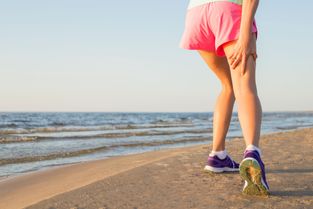0
item(s)
Cart is empty
|
Home
::
|
Charley Horse

A charley horse is another name that can be used to describe muscle spasm. Charley horses can appear in any muscle, but the part of the body where Charley horses have been found to be common is in the legs. These spasms are characterized by uncomfortable muscle contractions.
In the event that the contraction muscles fail to relax for a few seconds or more, pain can be intense. Severe cases of Charley horses can cause muscular pain that lasts several hours to a day. This is normal until the pain is prolonged or repeated.
What are the Causes of a Charley Horse?
Excessive use of muscle, dehydration, muscle strain, or simply maintaining a position over a long period of time can cause a Charley horse. In many cases, however, the cause is unknown.
Although most Charley horses are harmless, some may be associated with a basic health condition such as:
1. Insufficient blood supply. Contraction of the arteries which deliver blood to the legs (arteriosclerosis of the extremities) can cause pain similar to the cramps in your legs and feet during exercising. These cramps usually leave you shortly after you stop exercising.
2. Nerve Compression. Nerve compression in the spine (lumbar stenosis) can also cause cramp-like pain in the legs. The more you walk, the more pain gets worse. Walking in a slightly bent position - as you would push a basket in front of you - can improve or delay the onset of your symptoms.
3. Mineral depletion. Deficiency of minerals such as potassium, calcium or magnesium in diets can contribute to leg cramps. Diuretics - medicines often prescribed for high blood pressure has been found to have a negative effect as it can deplete these minerals.
4. Side effects of medication. Some drugs such as statins and furosemide (Lasix) can also cause Charley horse. A pointer is when the cramps start suddenly after you start taking a new drug.
5. Bad shoes. Bad shoes are known as a less known cause of Charley horse: your shoes. "You want to look out for your shoes, especially if you have gone from flat shoes to heels. It can also lead to cramps.
Risk Factors
Below are the factors that can increase the risk of developing a charley horse:
1. Age. Older individuals are prone to losing muscle mass, this makes the remaining muscle to be overstressed more easily.
2. Dehydration. Athletes who become tired and dehydrated during the hot weather play often develop Charley horse.
3. Pregnancy. It has also been discovered that Charley horses are common during pregnancy.
4. Medical conditions. If you have diabetes, nerves, liver or thyroid disorders, you are at greater risk of Charley horse.
What are the Symptoms of a Charley Horse?
Majority of the cases of charley horse are developing in the leg muscles, especially in the calf. In addition to sudden and acute pain, you can also feel or see a large piece of muscle tissue beneath the skin.
Charley Horse Treatment
Treatment for Charley Horse requires restoring the circulation and blood flow to the affected structures in your leg. Pain is caused when swelling, inflammation and decreased circulation generate a blockage, which causes blood flow to be interrupted or slowed. Treatment for this issue requires breaking up the accumulated fluids in your leg to allow for improved healing and quicker recovery.
Products recommended for symptoms of swelling, redness, pain, and inflammation, and if coolness makes your pain feel better:
Ice Substitute Poultice
Bruise Relief Liniment
Muscle Therapy Massage Oil
Products recommended when swelling and inflammation are gone, but you still feel pain, stiffness, weakness, and/or sensitivity in cold and damp weather, and if heat makes your pain feel better:
Pain Relief Liniment
Muscle Therapy Massage Oil
